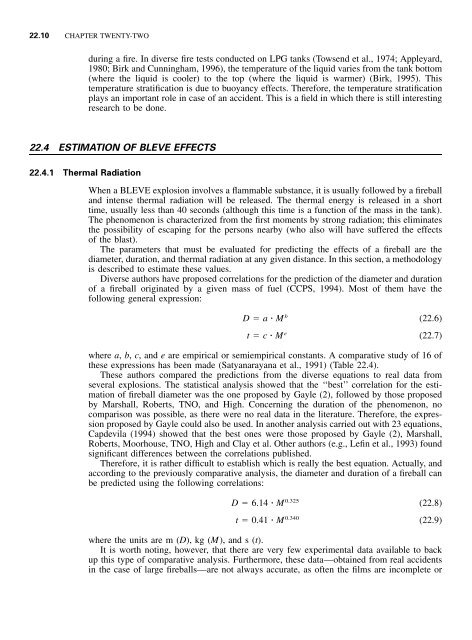CHAPTER 22 MODELING AND UNDERSTANDING BLEVEs
CHAPTER 22 MODELING AND UNDERSTANDING BLEVEs
CHAPTER 22 MODELING AND UNDERSTANDING BLEVEs
Create successful ePaper yourself
Turn your PDF publications into a flip-book with our unique Google optimized e-Paper software.
<strong>22</strong>.10 <strong>CHAPTER</strong> TWENTY-TWO<br />
during a fire. In diverse fire tests conducted on LPG tanks (Towsend et al., 1974; Appleyard,<br />
1980; Birk and Cunningham, 1996), the temperature of the liquid varies from the tank bottom<br />
(where the liquid is cooler) to the top (where the liquid is warmer) (Birk, 1995). This<br />
temperature stratification is due to buoyancy effects. Therefore, the temperature stratification<br />
plays an important role in case of an accident. This is a field in which there is still interesting<br />
research to be done.<br />
<strong>22</strong>.4 ESTIMATION OF BLEVE EFFECTS<br />
<strong>22</strong>.4.1 Thermal Radiation<br />
When a BLEVE explosion involves a flammable substance, it is usually followed by a fireball<br />
and intense thermal radiation will be released. The thermal energy is released in a short<br />
time, usually less than 40 seconds (although this time is a function of the mass in the tank).<br />
The phenomenon is characterized from the first moments by strong radiation; this eliminates<br />
the possibility of escaping for the persons nearby (who also will have suffered the effects<br />
of the blast).<br />
The parameters that must be evaluated for predicting the effects of a fireball are the<br />
diameter, duration, and thermal radiation at any given distance. In this section, a methodology<br />
is described to estimate these values.<br />
Diverse authors have proposed correlations for the prediction of the diameter and duration<br />
of a fireball originated by a given mass of fuel (CCPS, 1994). Most of them have the<br />
following general expression:<br />
b D � a � M (<strong>22</strong>.6)<br />
e t � c � M (<strong>22</strong>.7)<br />
where a, b, c, and e are empirical or semiempirical constants. A comparative study of 16 of<br />
these expressions has been made (Satyanarayana et al., 1991) (Table <strong>22</strong>.4).<br />
These authors compared the predictions from the diverse equations to real data from<br />
several explosions. The statistical analysis showed that the ‘‘best’’ correlation for the estimation<br />
of fireball diameter was the one proposed by Gayle (2), followed by those proposed<br />
by Marshall, Roberts, TNO, and High. Concerning the duration of the phenomenon, no<br />
comparison was possible, as there were no real data in the literature. Therefore, the expression<br />
proposed by Gayle could also be used. In another analysis carried out with 23 equations,<br />
Capdevila (1994) showed that the best ones were those proposed by Gayle (2), Marshall,<br />
Roberts, Moorhouse, TNO, High and Clay et al. Other authors (e.g., Lefin et al., 1993) found<br />
significant differences between the correlations published.<br />
Therefore, it is rather difficult to establish which is really the best equation. Actually, and<br />
according to the previously comparative analysis, the diameter and duration of a fireball can<br />
be predicted using the following correlations:<br />
0.325<br />
D � 6.14 � M (<strong>22</strong>.8)<br />
0.340<br />
t � 0.41 � M (<strong>22</strong>.9)<br />
where the units are m (D), kg (M), and s (t).<br />
It is worth noting, however, that there are very few experimental data available to back<br />
up this type of comparative analysis. Furthermore, these data—obtained from real accidents<br />
in the case of large fireballs—are not always accurate, as often the films are incomplete or

















